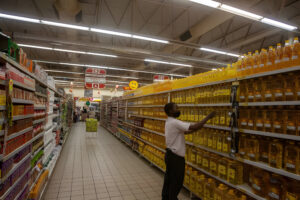South Africans are grappling with financial challenges as the rising cost of living forces many to rely on credit cards for daily expenses. A recent report from the Experian Consumer Default Index (CDI) highlights the precarious state of consumer finances in the country. Consumers are being hit hard according to the latest figures.
Financial Health of South African Consumers
The Experian CDI report reveals a concerning trend of consumers struggling to cope with escalating living costs. Neil Roets, CEO of Debt Rescue, one of South Africa’s leading debt counselling firms, sheds light on the gravity of the situation.
“Our research indicates that about two-thirds of the population are grappling with inadequate nourishment, with 66% of participants in the survey indicating that they are skipping meals due to financial constraints,” Roets shared. “To make ends meet, people are opting for cheaper, less nutritious food, which may have dire consequences, especially for families with young children.”
Inflation and Its Impact
The Consumer Price Inflation (CPI) remains a significant concern. Influenced by rising fuel costs and substantial increases in food prices, the CPI consistently exceeds the target range set by the South African Reserve Bank (SARB). This inflationary pressure, particularly in the Food and Non-Alcoholic Beverages sector, is straining household budgets.
Credit: A Double-Edged Sword
As living costs soar, there’s a marked increase in the demand for credit. While consumers are leaning on credit to manage their expenses, the heightened cost of living is impacting their ability to fulfil debt commitments. This challenge is evident in the reduced eligibility for new credit, with qualification metrics yet to reach pre-pandemic standards.
Factors Driving the Cost of Living
The Rand’s depreciation, among other elements, has contributed to escalating fuel prices, further straining the cost of living. The price of food and non-alcoholic beverages has witnessed a significant surge over the past year. This increase is linked to global grain and oilseed price hikes, a declining Rand, rising fertiliser expenses, and the impact of load shedding, which has augmented supply chain costs.
The first quarter of 2023 marked a pronounced rise in consumer credit demand. However, with approval rates hovering around 31%, it’s evident that a majority of applications are declined. This trend underscores the reality: while many are seeking credit to manage living costs, a significant number face rejection, primarily due to the strain on affordability amidst high CPI rates.
The Road Ahead for Consumers
Roets offers insights into the potential future landscape. He anticipates that food inflation might plateau at 10% by the close of 2023. However, there’s looming uncertainty with potential interest rate hikes on the horizon, largely driven by the consumer price index inflation, a consequence of Eskom’s load shedding challenges.
“Heightened load shedding escalates costs for retailers, inevitably passed on to consumers due to increased input expenses,” Roets explained. “I strongly advise against resorting to credit and store cards for food purchases, as this can spiral into unmanageable debt.”
The Experian CDI report’s findings underscore the financial hurdles South African consumers currently face. With the mounting cost of living, particularly due to surging food and fuel prices, many are turning to credit as a coping mechanism. Yet, with rising default rates and a constricting credit market, numerous households are set to face challenging times ahead.














